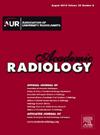Does Coronary CTA-Based Radiomics Have Incremental Value to Anatomic and Hemodynamic Analysis in Identifying Culprit Lesions in Patients with Acute Myocardial Infarction?
IF 3.9
2区 医学
Q1 RADIOLOGY, NUCLEAR MEDICINE & MEDICAL IMAGING
引用次数: 0
Abstract
Rationale and Objectives
Radiomics has great potential in identifying vulnerable plaques and predicting plaque progression. This study aims to investigate whether coronary CT angiography (CCTA)-based radiomics provides incremental value over anatomical and hemodynamic parameters for identifying culprit lesions in acute myocardial infarction (AMI).
Materials and Methods
This multicenter study retrospectively enrolled AMI patients who underwent CCTA within 48 h of admission. Culprit lesions were adjudicated using invasive coronary angiography and electrocardiograms. CCTA-based anatomical parameters (coronary artery disease reporting and data system [CAD-RADS], high-risk plaque [HRP]), hemodynamic parameters (fractional flow reserve derived by coronary CTA [FFRCT], change in FFRCT across the lesion [ΔFFRCT]), and the radiomics features of plaques were analyzed. The ability to identify culprit lesions was compared among four non-radiomics models (CAD-RADS, CAD-RADS+HRP, optimal hemodynamic, and combined anatomic-hemodynamic) and two radiomics-containing models (radiomics-only and integrated anatomic-hemodynamic-radiomics).
Results
Among 491 patients, 491 culprit and 1869 non-culprit lesions were analyzed. In the test cohorts 1 and 2, CAD-RADS+HRP+ΔFFRCT demonstrated the best diagnostic performance compared to other models, achieving AUCs of 0.877 (95% CI: 0.847–0.906) and 0.853 (95% CI: 0.817–0.885), respectively. CAD-RADS+HRP+ΔFFRCT significantly outperformed CAD-RADS, CAD-RADS+HRP, and Radiomics (all p<0.05). Additionally, CAD-RADS+HRP+ΔFFRCT+Radiomics did not outperform CAD-RADS+HRP+ΔFFRCT (p>0.05).
Conclusion
The CCTA-based anatomic-hemodynamic model accurately identifies culprit lesions in patients with AMI, while radiomics provides no significant incremental benefit.
冠状动脉cta放射组学在鉴别急性心肌梗死患者的罪魁祸首病变的解剖学和血流动力学分析中有增加价值吗?
基本原理和目的:放射组学在识别易损斑块和预测斑块进展方面具有很大的潜力。本研究旨在探讨基于冠状动脉CT血管造影(CCTA)的放射组学是否为识别急性心肌梗死(AMI)的罪魁祸首病变提供了解剖学和血流动力学参数的增量价值。材料和方法:本多中心研究回顾性纳入入院48小时内行CCTA的AMI患者。罪魁祸首病变是通过侵入性冠状动脉造影和心电图来判定的。分析基于ccta的解剖学参数(冠状动脉疾病报告和数据系统[CAD-RADS]、高危斑块[HRP])、血流动力学参数(冠状动脉CTA得出的血流储备分数[FFRCT]、FFRCT在病变范围内的变化[ΔFFRCT])以及斑块的放射组学特征。比较了四种非放射组学模型(CAD-RADS、CAD-RADS+HRP、最佳血流动力学和解剖-血流动力学联合)和两种含放射组学模型(仅放射组学和综合解剖-血流动力学-放射组学)识别罪魁祸首病变的能力。结果:在491例患者中,分析了491例罪魁祸首病变和1869例非罪魁祸首病变。在试验队列1和2中,CAD-RADS+HRP+ΔFFRCT与其他模型相比表现出最好的诊断性能,auc分别为0.877 (95% CI: 0.847-0.906)和0.853 (95% CI: 0.817-0.885)。CAD-RADS+HRP+ΔFFRCT显著优于CAD-RADS、CAD-RADS+HRP和Radiomics(所有pCT+Radiomics均不优于CAD-RADS+HRP+ΔFFRCT (p>0.05)。结论:基于ccta的解剖-血流动力学模型准确地识别了AMI患者的罪魁祸首病变,而放射组学没有提供明显的增量益处。
本文章由计算机程序翻译,如有差异,请以英文原文为准。
求助全文
约1分钟内获得全文
求助全文
来源期刊

Academic Radiology
医学-核医学
CiteScore
7.60
自引率
10.40%
发文量
432
审稿时长
18 days
期刊介绍:
Academic Radiology publishes original reports of clinical and laboratory investigations in diagnostic imaging, the diagnostic use of radioactive isotopes, computed tomography, positron emission tomography, magnetic resonance imaging, ultrasound, digital subtraction angiography, image-guided interventions and related techniques. It also includes brief technical reports describing original observations, techniques, and instrumental developments; state-of-the-art reports on clinical issues, new technology and other topics of current medical importance; meta-analyses; scientific studies and opinions on radiologic education; and letters to the Editor.
 求助内容:
求助内容: 应助结果提醒方式:
应助结果提醒方式:


